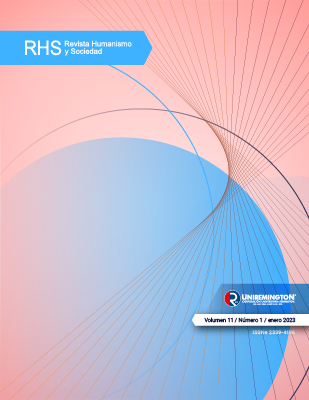A Communication Model Proposal Based on Transmedia Narrative and Spreadable media
Main Article Content
Abstract
This article presents a proposal for a communication model based on transmedia narrative and spreadable media, both concepts developed by the American academic Henry Jenkins (2008 and 2013). This proposal was intended to facilitate the dissemination of content associated with a strategy to promote family coexistence in the Colombian city of Medellín and its metropolitan area. The process was designed in phases, in which methods of Internet audience studies and content analysis were combined. The article is divided into five parts: first, the model is introduced, defined and justified; second, its use is delimited; third, its elements are described; fourth, its structure is presented; finally, the text closes presenting a series of conclusions and the limitations of this proposal. The conclusions show alternative dynamics of production, narration, consumption and dissemination of stories to facilitate other processes that are in tune with the purposes of communication for social change, in particular, the generation of involvement and commitment of users. The model is not intended to be replicable, but to represent a specific moment, circumstances and situations.
Downloads
Article Details

This work is licensed under a Creative Commons Attribution-NonCommercial-ShareAlike 4.0 International License.
Those authors who publish with this journal agree to the following terms:
The designated authors will retain copyright of all papers and grant the journal the right of first publication of their work, which will be simultaneously published under the Creative Commons Attribution License that allows third parties to share the work, as long as its author is attributed and this journal is identified as the original publisher.
Authors may enter into separate, additional non-exclusive licensing agreements for the distribution of the published work (e.g., post it to an institutional telematic archive or publish it in a monographic volume) as long as this journal is acknowledged as the original publisher.
References
Álvarez Berciano, R. (2012). Tensiones de la narrativa serial en el nuevo sistema mediático. Anàlisi, (M), 33-47. http://doi.org/10.7238/a.v0iM.1500 DOI: https://doi.org/10.7238/a.v0iMonografico.1500
González-Martínez, J., Esteban-Guitart, M., Rostan-Sánchez; C., Serrat-Sellabona, E., & Estebanell-Minguell, M. (2019). What’s up with transmedia and education? A literature review. Digital Education Review, (36), 207-222. https://doi.org/10.1344/der.2019.36.207-222 DOI: https://doi.org/10.1344/der.2019.36.207-222
Jenkins, H. (2008). Convergence culture: la cultura de la convergencia de los medios de comunicación. Paidós.
Jenkins, H. (2009a). Fans, blogueros y videojuegos: la cultura de la colaboración. Paidós.
Jenkins, H. (21 de diciembre de 2009b). The Revenge of the Origami Unicorn: Seven Principles of Transmedia Storytelling. Futures of entertainment conference. http://www.convergenceculture.org/weblog/2009/12/the_revenge_of_the_origami_uni.php
Jenkins, H., Ford, S., & Green, J. (2015). Cultura transmedia: la creación de contenido y valor en una cultura en red. Gedisa.
Jenkins, H.; Ford, S., & Green, J. (2013). Spreadable Media: Creating Value and Meaning in a Networked Culture. NYU Press.
Kalogeras, S. (2013). Media-Education Convergence: Applying Transmedia Storytelling Edutainment in E-Learning Environments. International Journal of Information and Communication Technology Education, 9(2), 1-11. https://doi.org/10.4018/jicte.2013040101 DOI: https://doi.org/10.4018/jicte.2013040101
Lutkenhaus, R., Wang, H., Singhal, A., Jansz, J., & Bouman, M. (2022). Using markers for digital engagement and social change: Tracking meaningful narrative exchange in transmedia edutainment with text analytics techniques. Digital Health, 8, 205520762211078. https://doi.org/10.1177/20552076221107892 DOI: https://doi.org/10.1177/20552076221107892
Lutkenhaus, R., Jansz, J., & Bouman, M. (2020). Toward spreadable entertainment-education: leveraging social influence in online networks. Health Promotion International, 35(5), 1241-1250. https://doi.org/10.1093/heapro/daz104 DOI: https://doi.org/10.1093/heapro/daz104
Marino, G. (2020). Semiótica de la propagabilidad: Un enfoque sistemático de las imágenes virales a través de Internet. La Tadeo DeArte, 6(6), 22-55. https://doi.org/10.21789/24223158.1415 DOI: https://doi.org/10.21789/24223158.1415
Martínez Veleño, C. A., & Sosa Gómez, M. S. (2016). Aportaciones y diferencias entre comunicación en salud, comunicación para el desarrollo y para el cambio social. Revista de Comunicación y Salud, (6), 69-80. https://doi.org/10.35669/revistadecomunicacionysalud.2016.6(1).71-82 DOI: https://doi.org/10.35669/revistadecomunicacionysalud.2016.6(1).71-82
Murray, J. (1999). Hamlet en la holocubierta: el futuro de la narrativa en el ciberespacio. Paidós.
Naab, T., & Sehl, A. (2017). Studies of user-generated content: A systematic review. Journalism, 18(10), 1256-1273. https://doi.org/10.1177/1464884916673557 DOI: https://doi.org/10.1177/1464884916673557
Pick, S., Sirkin, J., Ortega, I., Osorio, P., Martínez, R., Xocolotzin, U., & Givaudan, M. (2007). Escala para medir agencia personal y empoderamiento (ESAGE). Revista Interamericana de Psicología, 41(3), 295-304. https://www.redalyc.org/articulo.oa?id=28441304
Sangalang, A., Quintero Johnson, J., & Ciancio, K. (2013). Exploring audience involvement with an interactive narrative: Implications for incorporating transmedia storytelling into entertainment-education campaigns. Critical Arts, 27(1), 127-146. https://doi.org/10.1080/02560046.2013.766977 DOI: https://doi.org/10.1080/02560046.2013.766977
Scolari, C. (2013). Narrativas transmedia: cuando todos los medios cuentan. Deusto.
Scolari, C., Lugo, N., & Masanet, M. (2019). Educación Transmedia. De los contenidos generados por los usuarios a los contenidos generados por los estudiantes. Revista Latina de Comunicación Social, (74), 116-132. https://doi.org/10.4185/RLCS-2019-1324 DOI: https://doi.org/10.4185/RLCS-2019-1324
Soriano, C. (2016). Transmedia mobilization: Agency and literacy in minority productions in the age of spreadable media. The Information Society, 32(5), 354-363. https://doi.org/10.1080/01972243.2016.1212620 DOI: https://doi.org/10.1080/01972243.2016.1212620
Soy Ana Torres. (2015). Soy Ana Torres - Episodio 1 - "El video que no fue" [Video]. https://www.youtube.com/watch?v=dKOv-zmQeAU
Tufte, T. (2004). Eduentretenimiento en la comunicación para el VIH/Sida. Más allá del mercadeo, hacia el empoderamiento. Investigación y Desarrollo, 12(1), 24-43. https://rcientificas.uninorte.edu.co/index.php/investigacion/article/view/1087
Tufte, T. (2008). El edu-entretenimiento: buscando estrategias comunicacionales contra la violencia y los conflictos. Intercom – Revista Brasilera de Ciencias de la Comunicación, 31(1), 157-181. https://doi.org/10.1590/rbcc.v31i1.199
Wang, H., & Singhal, A. (2016). East Los High: Transmedia Edutainment to Promote the Sexual and Reproductive Health of Young Latina/o Americans. American Journal of Public Health, 106(6), 1002-1010. https://doi.org/10.2105/AJPH.2016.303072 DOI: https://doi.org/10.2105/AJPH.2016.303072
Wang, H., Singhal, A., Quist, C., Sachdev, A., & Liu, S. (2019). Aligning the stars in East Los High: How authentic characters and storylines can translate into real-life changes through transmedia edutainment. SEARCH Journal of Media and Communication Research, 11(3), 1-22.
